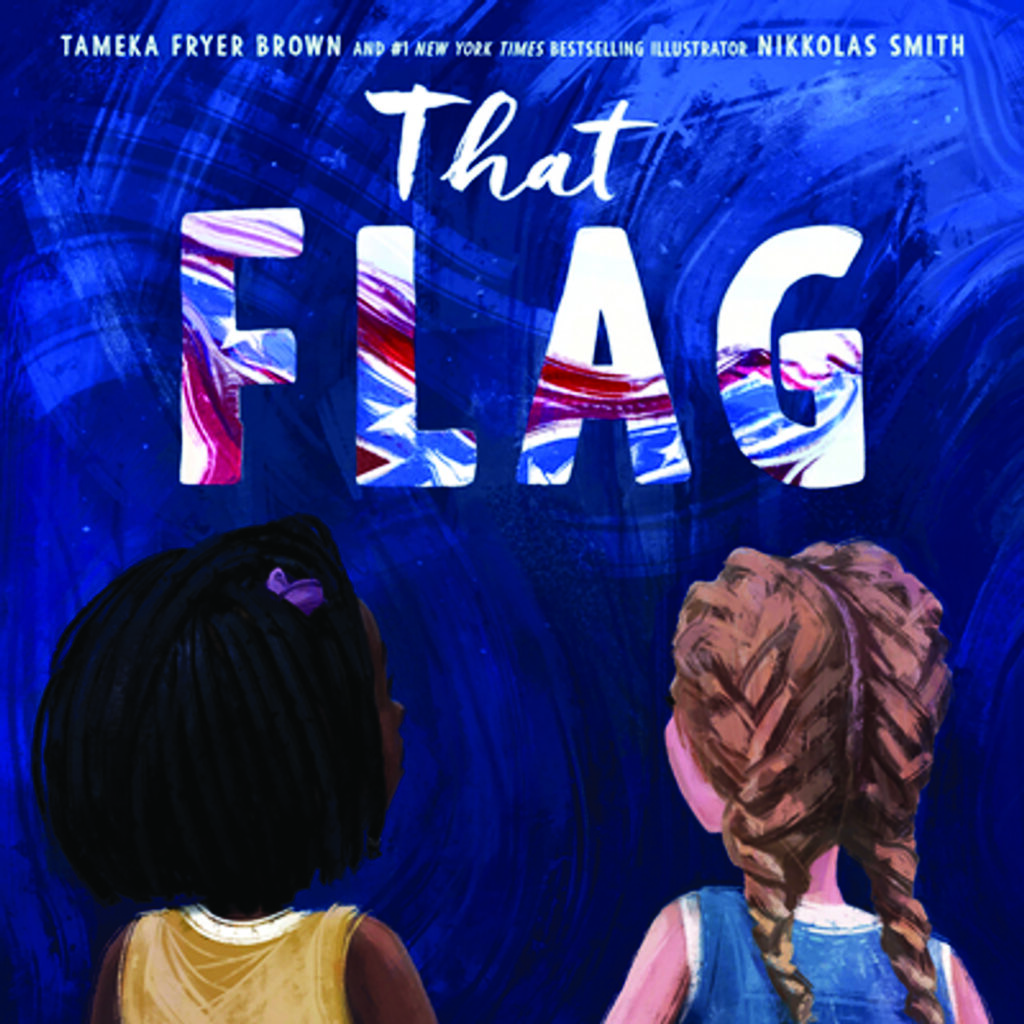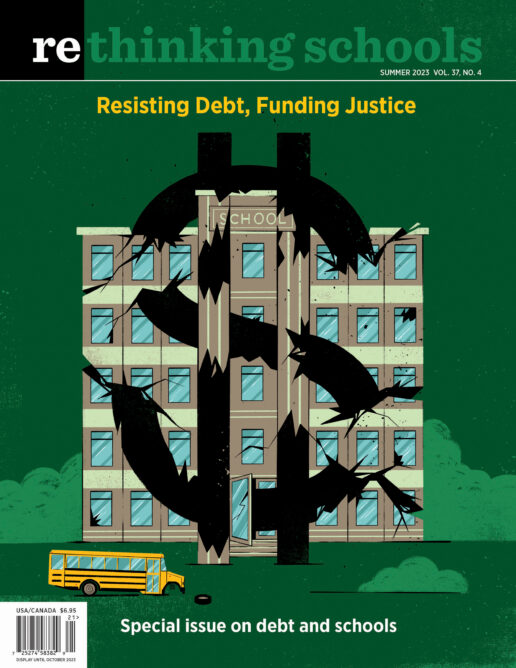Teaching Historic and Contemporary Racism in Elementary Classrooms
That Flag
Written by Tameka Fryer Brown
Illustrated by Nikkolas Smith
(HarperCollins, 2023)
40 pp.

The preservice teachers I work with tend to express both an anxiety and a desire to talk to their elementary students about race and racism. They know that these conversations are important, but they’re also afraid to say the wrong thing. Particularly for my white students, conversations around race and racism were not modeled in their own familial or schooling experiences. Instead of explicitly discussing race, they tend to focus on ideas of kindness and “loving everyone” as they begin to write their own lesson plans and start their student teaching. Although being kind is generally a good thing, it does little to address historic, structural, and contemporary racism — issues that permeate students’ lives and schooling experiences.
To help facilitate these learning experiences, I’m always searching for children’s books that open up opportunities for honest dialogue around race and racism. That Flag, written by Tameka Fryer Brown and breathtakingly illustrated by Nikkolas Smith, does an exceptional job of providing this opportunity. This picture book illustrates the United States’ history of racism, the decades-long activism of Black communities post-Emancipation, and the ways that these struggles for racial justice continue today.
I read the book to my class of preservice elementary teachers. Before reading, I asked my students to attend to specific aspects of the book. “As I read, I want you to pay particular attention to the roles that the teacher, Ms. Greyson, and the families play in facilitating difficult conversations around race and racism. Oftentimes teachers are afraid to lean into those conversations, which can lead us to shut down students’ questions or comments when they arise in our classrooms. This teacher does something different; pay close attention to these moves. In addition, the knowledge these students gain from home plays a crucial role — something that we should always think about in our teaching.”
I began to read the story, which centers the relationship between two elementary school classmates, Keira, who is Black, and Bianca, who is white. Although not specified, the girls appear to be about 8 or 9 years old. Keira and Bianca love playing together at school, but Keira isn’t allowed to play with Bianca outside of school because of “that flag”: a Confederate flag her family flies on their front porch.
When the class takes a field trip to the Southern Legacy Museum, Keira’s dad comes along on the trip. Although we don’t see how the rest of the class engages with the museum, we see Keira’s dad pull her aside to tell her there’s something she needs to see. Keira’s father leads her through the exhibit on the Confederacy, and she sees photos she has never seen before: “dogs and water hoses . . . teenagers crying in the streets . . . scary men in white gowns holding torches and flags . . . that flag.” For the first time, Keira sees the history behind that flag.
At home that evening, Keira’s family shares stories she hasn’t heard before: stories of her grandmother confronting violent racism at school, her parents being threatened and chased, about Selma and the Freedom Rides, and about “the things Black people have to do every day to stay safe.” Fryer Brown tells each of these stories through one sentence and an illustrated vignette, and in each one, the Confederate flag is visible.
Back at school the next day, Keira “waits for Bianca to say something about the pictures” but she “talks about her puppy instead.” Internally, Keira wrestles with how she can maintain a friendship with Bianca: “I guess those pictures didn’t bother her. I guess we’re not the same. I guess we’re not best friends after all.”
At this point in the story, I paused and turned to my students. “On the surface, it looks like Bianca is being kind. She hasn’t said any mean words or done anything purposely to hurt Keira’s feelings, yet a division has formed in their friendship. What’s happening here? Why isn’t Bianca’s ‘kindness’ enough?” I asked, using air quotes around the word “kindness.” I gave my students time to think before answering.
“I think Bianca’s privilege is being revealed,” Veronica shared. “She thinks everything is fine because racism doesn’t personally impact her, and no one has taught her how racism might impact other people. She doesn’t even pay attention to racism; it’s kind of invisible to her. But Keira knows, and now that she knows, she can’t unknow it.”
“Absolutely,” I affirmed. “There are very different conversations happening at these two girls’ homes, and while we don’t know if Bianca’s family is using explicitly racist language (Fryer Brown leaves us wondering about Bianca’s home life, highlighting Keira’s instead) we can definitely infer that they are not having explicitly anti-racist conversations. Talking about race and racism is crucial, especially for white students.”
Soon after this part of the book, Ms. Greyson asks the class what they learned at the museum. Keira shares, “The Confederate flag is racist,” and Bianca responds that it “stands for Southern heritage.” Reaching a particularly crucial moment in the story, I paused again. Before reading Ms. Greyson’s response, I asked the class, “I’m not sure Ms. Greyson was expecting this response from her students when she asked that question. How should teachers respond in a moment like this? What do you hope Ms. Greyson will do?”
“I don’t know what to do in a moment like this,” shared Brittany. “This is exactly what I’m afraid of!” Several classmates nodded in agreement.
Maria pushed back a bit. “Yeah, I agree that it’s hard, but I think we have to have these conversations. We can’t shut it down. Even if we’re afraid of parents, if students bring up these conversations, we have a responsibility to address it.”
“Talking about race and racism is crucial, especially for white students.“
“I’m so glad you brought up parents,” I responded. “I want you all to close your eyes for a moment, and think about the caregivers you imagine when you say you’re afraid of parents. Open your eyes when you have an image in your head.” Once my students had their eyes open, I asked, “Who were you picturing?” All my students agreed that they were picturing white parents. “When you make decisions based off of that fear,” I explained, “you are prioritizing that parent. You are prioritizing the adults who already have the most privilege. Instead, I want you to think about how you can honor and uplift the knowledge and experiences of those impacted by racism. In this scenario, Ms. Greyson has a choice to reinforce the racism of Bianca’s family, or to address the harm that has been done to Keira’s. Let’s see what she does.”
Ms. Greyson responds with the truth. She tells the girls, “The Confederacy fought a war to keep Black people enslaved. Their battle flag is still used by hate groups who want white people to rule.” When Bianca asks, “Why would my family fly a flag like that?” Ms. Greyson responds, “I don’t know, but it’s a good question to ask.”
I paused again: “What did she do?”
“She didn’t say much, but she certainly told the truth,” Olivia volunteered.
“Yeah,” Brittany added. “She responded in a way that honored the realities of the Black family, and not the racism of the white family.”
“You’re right,” I said. “Ms. Greyson honors and affirms Keira’s new knowledge while also opening up the opportunity for Bianca to learn difficult and uncomfortable history. She clearly said that the Confederate flag is a symbol of racism; she leaned into discomfort instead of pulling away. If she’s afraid of Bianca’s family, she didn’t let that get in the way of teaching the truth.”
I turned back to the book and continued reading. In the remaining pages of the story, the community is rocked by a local racially motivated killing: three white men shoot and kill a Black couple in their own front yard. Through Nikkolas Smith’s poignant illustrations, we see Keira and her family watching the news in despair, with the headline “Hate crimes on the rise” running underneath the footage. On the opposite page, Bianca’s family silently watches the same footage under the headline “Shooters lose control in heated conflict.” The one thing both news scenes have in common is the image: A white man holding a Confederate flag.
Shortly after, both families attend a vigil in honor of the murdered Black couple. Keira is shocked to see Bianca and her family and wonders why they came. On the way home from the vigil, Keira’s family drives by Bianca’s house and sees that their Confederate flag has been removed.
Although Keira’s family plays a prominent role in the book, readers are never given more than a peek into Bianca’s home, and we don’t hear her parents speak. We don’t know why the flag was taken down. We are left to wonder what role Bianca has played in facilitating change within her family. Whether the change is genuine or performative, we don’t know.
Although the story leaves readers with a bit of hope for the girls’ friendship, it’s clear that kindness isn’t enough to sustain an interracial friendship in which structural racism is ignored. Nothing is wrapped up in a bow, and in the same way that Ms. Greyson encourages Bianca to continue asking questions, it seems that Fryer Brown asks her readers to do the same. Instead of leaving us with a clear resolution, the book invites us into conversation — about students’ lives, the realities of racism, the use of the Confederate flag, and U.S. history and current events.
As I reflect on the conversations we had about That Flag, I continue to revise and add on to this lesson. I chose to focus on Ms. Greyson’s teaching moves and the idea that kindness can’t combat structural racism, but teachers can take many additional avenues. In upcoming semesters, I may ask students to plan read-aloud questions, to think about how to use the book for different grade levels, and to brainstorm how we can use primary sources and informational texts for historical inquiry into the vignettes shared by Keira’s family, such as Selma and the Freedom Rides.
Upper elementary teachers may use this text to dovetail into questions such as: What work would Bianca need to do to have a genuine friendship with Keira? How are Keira’s family’s experiences different from Bianca’s, and why is that important? How does our country’s history impact our current day? What is the history of the Confederate flag, and how have people engaged in collective action to have Confederate flags and symbols removed from their communities? What should we do when we encounter hate symbols?
Teacher educators may use this book as a springboard to discuss questions like How should Ms. Greyson continue this work in her classroom? How can teachers use field trips to foster honest engagement with history? How did Ms. Greyson’s inclusion of families further support her students’ learning? What kinds of knowledge and questions do our students bring into our classrooms with them, and how can we use this knowledge to shape curriculum?
That Flag does many things, but one thing it does not do is sugarcoat racism. It teaches the realities of the history of racism, the Confederacy, and racial terrorism in the United States, and it reveals the pivotal roles that teachers and families play in these conversations. It’s a must-have for teachers, teacher educators, and families, and is a powerful resource to open up important conversations around honest history.

